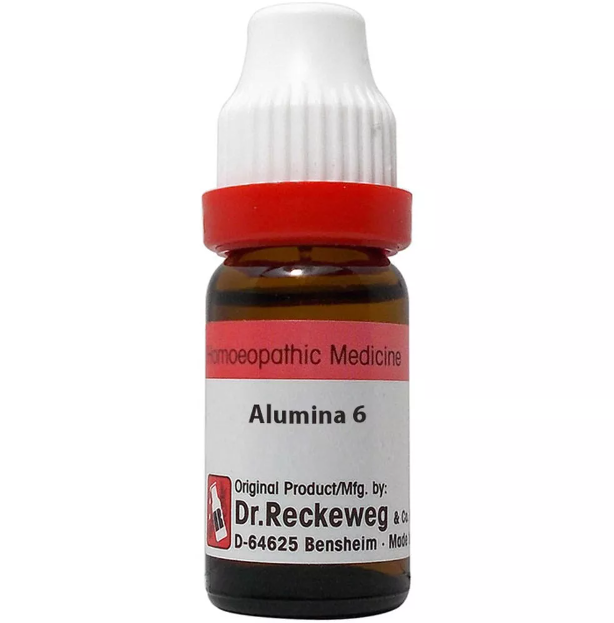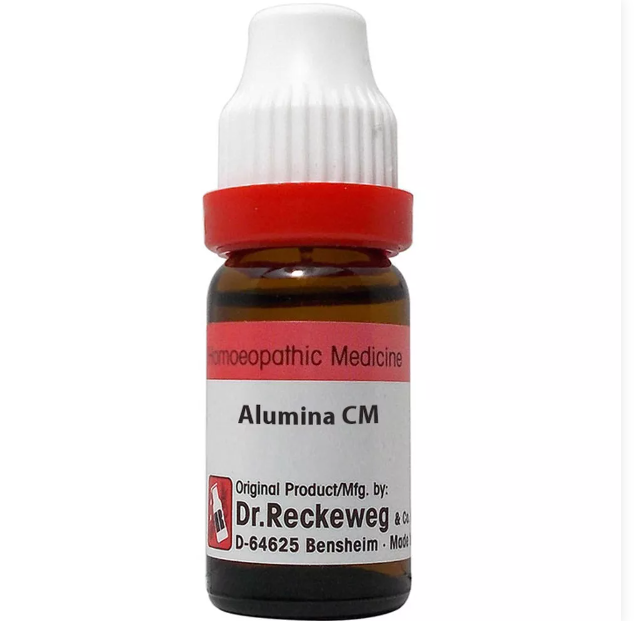ALUMINA 6C, 12C, 30C, 200C, 1M, 10M USES AND SYMPTOMS
 ALUMINA
ALUMINA
(Commonly known as Aluminum Oxide, Argilla)
Alum.
A widespread condition aligning with this substance involves dryness in the mucous membranes and skin, along with a tendency toward weakened muscle states. Elderly individuals lacking vital warmth or prematurely aged individuals experiencing debility can find relief in Alumina. Sluggish functions, heaviness, numbness, staggering, and the distinctive constipation all find a potent remedy in Alumina. There is a susceptibility to colds in the head and eructations in spare, dry, thin individuals. It’s particularly effective for delicate children born from artificial baby foods.
Mind: Low spirits; fear of losing sanity. Confusion about personal identity. Impatience, hastiness. Time seems to pass slowly. Variable mood. Improvement as the day progresses. Suicidal thoughts triggered by the sight of a knife or blood.
Head: Sharp, burning pain in the head accompanied by dizziness, worse in the morning but alleviated by food. Pressure in the forehead, as if wearing a tight hat. Difficulty walking without open eyes. Throbbing headache with constipation. Dizziness with nausea, improved after breakfast. Hair falling out; itchy and numb scalp.
Eyes: Objects appear yellow. Eyes feel cold. Dry, burning, smarting lids, worsening in the morning; chronic conjunctivitis. Drooping eyelids. Cross-eyed.
Ears: Humming; roaring. Sensation of the Eustachian tube being blocked.
Nose: Pain at the root of the nose. Reduced sense of smell. Runny nose. Cracked tip of the nose, sore nostrils, redness; worsened by touch. Scabs with thick yellow mucus. Red, scaly inflammation. Dry atrophic ozena. Swollen and boggy membranes.
Face: Feels as if a proteinaceous substance has dried on it. Blood-boils and pimples. Twitching of the lower jaw. Blood rush to the face after eating.
Mouth: Sore. Bad breath. Teeth covered with debris. Sore, bleeding gums. Tension in the jaw joint when opening or chewing.
Throat: Dry, sore; difficulty swallowing, constricted esophagus, sensation of a splinter or plug in the throat. Irritable and relaxed throat. Appears parched and glazed. Clergyman’s sore throat in thin individuals. Thick, sticky mucus drips from the back of the nose. Constant urge to clear the throat.
Stomach: Unusual cravings for chalk, charcoal, dry food, tea-grounds. Heartburn; feeling constricted. Aversion to meat. Dislike for potatoes. No desire to eat. Can swallow but in small amounts. Esophageal constriction.
Abdomen: Colic resembling painter’s colic. Pressure in both groins toward sexual organs. Left-sided abdominal complaints.
Stool: Hard, dry, knotty stools; no urge. Sore, dry, inflamed, bleeding rectum. Itching and burning in the anus. Difficulty passing even soft stool. Severe straining. Constipation in infants and old people due to an inactive rectum, and in women with very sedentary habits. Diarrhea during urination. Painful urging long before stool, followed by straining.
Urinary: Paretic bladder muscles, straining required to urinate. Kidney pain with mental confusion. Frequent urination in the elderly. Difficulty initiating.
Male: Increased desire. Involuntary emissions during straining. Prostatic discharge.
Female: Early, short, scanty, pale menses followed by exhaustion. Acrid, profuse, transparent, ropy leucorrhea with burning; worse during daytime and after menses. Relieved by cold water washing.
Respiratory: Cough upon waking in the morning. Hoarseness, aphonia, tickling in the larynx; wheezing, rattling breath. Cough triggered by talking or singing in the morning. Chest feels constricted. Condiments induce cough. Talking worsens chest soreness.
Back: Sharp pains. Gnawing sensation, as if from a hot iron. Pain along the spine with paralytic weakness.
Extremities: Pain in the arms and fingers, as if penetrated by a hot iron. Paralyzed feeling in the arms. Legs falling asleep, especially when sitting cross-legged. Staggering while walking (locomotor ataxia). Numbness in the heels. Tender soles; feel soft and swollen when stepping. Pain in the shoulder and upper arm. Gnawing beneath fingernails. Brittle nails. Inability to walk unless eyes are open or during the day. Degeneration and paralysis of lower limbs.
Sleep: Restless; anxious and confused dreams. Morning drowsiness.
Skin: Chapped, dry, scaly. Brittle nails. Unbearable itching when getting warm in bed. Must scratch until it bleeds, then becomes painful. Brittle skin on fingers.
Modalities: Worsened periodically, in the afternoon, from potatoes. Worse in the morning upon waking up, in a warm room. Improved in open air, from cold washing, in the evening, and on alternate days. Better in damp weather.
Relationship: Compare with Aluminum chloride (pains of locomotor ataxia, lower triturations in water). Slag-Aluminium-silico-sulpho-calcite 3x (anal itching, piles, constipation, flatulent distention); Sec., Lath., Plb. Aluminum aceticum solution (externally a lotion for putrid wounds and skin infections. Controls hemorrhage from uterine inertia, parenchymatous hemorrhage from various organs 2-3% solution. Hemorrhage following tonsillectomy is controlled by rinsing out the nasopharynx with a 10% solution).
Complementary: Bryonia.
Antidotes: Ipecac, Chamomilla.
Dosage: Sixth to thirtieth and higher. Action is slow to develop.
SYMPTOMS OF ALUMINA
 Mind:
Mind:
- Low spirits; fear of losing sanity.
- Confusion about personal identity.
- Impatience, hastiness.
- Perception of time passing slowly.
- Variable mood.
- Improvement as the day progresses.
- Suicidal thoughts triggered by the sight of a knife or blood.
Head:
- Sharp, burning pain in the head with dizziness, worse in the morning but alleviated by food.
- Pressure in the forehead, as if wearing a tight hat.
- Difficulty walking without open eyes.
- Throbbing headache with constipation.
- Dizziness with nausea, improved after breakfast.
- Hair falling out; itchy and numb scalp.
Eyes:
- Objects appear yellow.
- Eyes feel cold.
- Dry, burning, smarting lids, worsening in the morning; chronic conjunctivitis.
- Drooping eyelids.
- Cross-eyed.
Ears:
- Humming; roaring.
- Sensation of the Eustachian tube being blocked.
Nose:
- Pain at the root of the nose.
- Reduced sense of smell.
- Runny nose.
- Cracked tip of the nose, sore nostrils, redness; worsened by touch.
- Scabs with thick yellow mucus.
- Red, scaly inflammation.
- Dry atrophic ozena.
- Swollen and boggy membranes.
Face:
- Feels as if a proteinaceous substance has dried on it.
- Blood-boils and pimples.
- Twitching of the lower jaw.
- Blood rush to the face after eating.
Mouth:
- Sore.
- Bad breath.
- Teeth covered with debris.
- Sore, bleeding gums.
- Tension in the jaw joint when opening or chewing.
Throat:
- Dry, sore; difficulty swallowing, constricted esophagus, sensation of a splinter or plug in the throat.
- Irritable and relaxed throat.
- Appears parched and glazed.
- Clergyman’s sore throat in thin individuals.
- Thick, sticky mucus drips from the back of the nose.
- Constant urge to clear the throat.
Stomach:
- Unusual cravings for chalk, charcoal, dry food, tea-grounds.
- Heartburn; feeling constricted.
- Aversion to meat.
- Dislike for potatoes.
- No desire to eat.
- Can swallow but in small amounts.
- Esophageal constriction.
Abdomen:
- Colic resembling painter’s colic.
- Pressure in both groins toward sexual organs.
- Left-sided abdominal complaints.
Stool:
- Hard, dry, knotty stools; no urge.
- Sore, dry, inflamed, bleeding rectum.
- Itching and burning in the anus.
- Difficulty passing even soft stool.
- Severe straining.
- Constipation in infants and old people due to an inactive rectum.
- In women with very sedentary habits.
- Diarrhea during urination.
- Painful urging long before stool, followed by straining.
Urinary:
- Paretic bladder muscles, straining required to urinate.
- Kidney pain with mental confusion.
- Frequent urination in the elderly.
- Difficulty initiating.
Male:
- Increased desire.
- Involuntary emissions during straining.
- Prostatic discharge.
Female:
- Early, short, scanty, pale menses followed by exhaustion.
- Acrid, profuse, transparent, ropy leucorrhea with burning; worse during daytime and after menses.
- Relieved by cold water washing.
Respiratory:
- Cough upon waking in the morning.
- Hoarseness, aphonia, tickling in the larynx; wheezing, rattling breath.
- Cough triggered by talking or singing in the morning.
- Chest feels constricted.
- Condiments induce cough.
- Talking worsens chest soreness.
Back:
- Sharp pains.
- Gnawing sensation, as if from a hot iron.
- Pain along the spine with paralytic weakness.
Extremities:
- Pain in the arms and fingers, as if penetrated by a hot iron.
- Paralyzed feeling in the arms.
- Legs falling asleep, especially when sitting cross-legged.
- Staggering while walking (locomotor ataxia).
- Numbness in the heels.
- Tender soles; feel soft and swollen when stepping.
- Pain in the shoulder and upper arm.
- Gnawing beneath fingernails.
- Brittle nails.
- Inability to walk unless eyes are open or during the day.
- Degeneration and paralysis of lower limbs.
Sleep:
- Restless; anxious and confused dreams.
- Morning drowsiness.
Skin:
- Chapped, dry, scaly.
- Brittle nails.
- Unbearable itching when getting warm in bed.
- Must scratch until it bleeds, then becomes painful.
- Brittle skin on fingers.
Modalities:
- Worsened periodically, in the afternoon, from potatoes.
- Worse in the morning upon waking up, in a warm room.
- Improved in open air, from cold washing, in the evening, and on alternate days.
- Better in damp weather.
selection of the potency
Individualization:
- Homeopathy is based on the principle of treating the individual, not just the disease. The unique symptoms and characteristics of the person are crucial in determining the most suitable potency.
Intensity of Symptoms:
- The intensity of the symptoms guides the choice of potency. If the symptoms are intense and acute, a lower potency (e.g., 6C, 30C) might be considered. For chronic conditions with less intensity, higher potencies (e.g., 200C, 1M) may be appropriate.
Sensitivity of the Patient:
- Some individuals are more sensitive to homeopathic remedies, while others may require higher potencies. The practitioner considers the patient’s sensitivity when selecting the potency.
Acute vs. Chronic Conditions:
- Lower potencies are often used for acute conditions, while higher potencies may be considered for chronic or long-standing issues.
Previous Response to Potencies:
- The patient’s response to previous homeopathic treatments helps guide the choice of potency. If a particular potency has been effective in the past, it may be repeated or adjusted as needed.
Vital Force and Susceptibility:
- Homeopathy views illness as a disturbance in the vital force. The practitioner assesses the patient’s overall vitality and susceptibility to determine the appropriate potency.
Aggravation or Amelioration:
- The direction of the symptom response (aggravation or amelioration) after taking a remedy can influence the choice of potency.
Miasmatic Considerations:
- In classical homeopathy, the concept of miasms (inherited disease tendencies) is considered. The practitioner take this into account when selecting the potency.
Practitioner Experience:
- The experience and preference of the homeopathic practitioner play a role. Some practitioners may have success with certain potencies based on their clinical experience.
SAFETY INFORMATION
- Do not exceed the recommended dose by physician
- Keep out of the reach of children
- Store in a cool dry place away from direct sunlight
- Maintain half an hour gap between food/drink/any other medicines and homoeopathic medicine
- Avoid any strong smell in the mouth while taking medicine e.g. camphor, garlic, onion, coffee, hing
Medicine images use for reference only selection of homeopathic medicine depends on the individual’s specific symptoms and overall constitution. Moreover, homeopathy is a holistic system of medicine that treats the individual as a whole. In addition to addressing the physical symptoms, it takes into account the emotional and mental state of the person. Consequently, it’s crucial to consult with a qualified homeopathic practitioner for personalized treatment.
The information provided on this website is intended solely for educational purposes. Always seek the advice of your physician or other qualified health provider.
